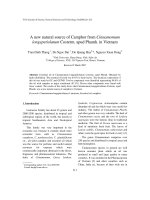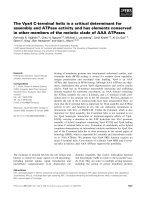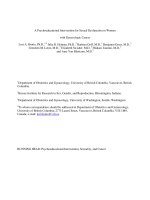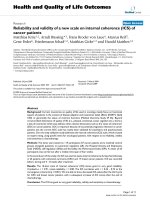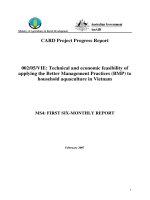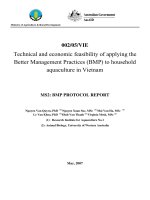A PSYCHO-EDUCATIONAL INTERVENTION FOR SYMPTOM CLUSTER MANAGEMENT AMONG CANCER PATIENTS UNDERGOING TREATMENT IN VIETNAM
Bạn đang xem bản rút gọn của tài liệu. Xem và tải ngay bản đầy đủ của tài liệu tại đây (10.75 MB, 408 trang )
Queensland University of Technology
A PSYCHO-EDUCATIONAL INTERVENTION FOR
SYMPTOM CLUSTER MANAGEMENT AMONG CANCER
PATIENTS UNDERGOING TREATMENT IN VIETNAM
Nguyen Thuy Ly
RN, BN, MSN
Submitted in fulfilment of the requirements for the degree of
Doctor of Philosophy
School of Nursing
Faculty of Health
Queensland University of Technology
2018
Supervisors
Principal Supervisor
Professor Patsy Yates
Head, School of Nursing,
Queensland University of Technology
Director, Centre for Palliative Care Research and Education, Queensland Health
Associate Supervisor
Associate Professor Kimberly Alexander
Senior Lecturer, School of Nursing,
Queensland University of Technology
Senior Research Fellow for Holy Spirit Northside Private Hospital
A psycho-educational intervention for symptom cluster management among cancer patients
i
Publications Related to this Thesis
Peer- reviewed publications
1. Nguyen LT, Yates P, Annoussamy LC, & Truong TQ. The effectiveness of nonpharmacological interventions in the management of symptom clusters in adult cancer
patients: A systematic review protocol. JBI Database of Systematic Reviews and
Implementation Reports. 2016; 14(4): 49-59.
Conference presentations
1. Nguyen LT, Yates P & Annoussamy LC. How effective non-pharmacological
interventions are in the management of symptom clusters among cancer patients?: A
systematic review. World Cancer Congress. 2016, Paris, France.
2. Nguyen LT, Yates P & Alexander K. Development of an evidenced-based psychoeducational intervention to manage symptom clusters in cancer patients within the
context of low-middle income country. International Conference on Cancer Nursing.
2017, Anaheim, California, United States.
ii
A psycho-educational intervention for symptom cluster management among cancer patients
Keywords
•
Cancer
•
Symptom cluster
•
Fatigue
•
Pain
•
Sleep disturbance
•
Psycho-educational intervention
•
Symptom management
•
Self-management
A psycho-educational intervention for symptom cluster management among cancer patients
iii
Abstract
Rationale
Pain, fatigue and sleep disturbance form a common symptom cluster amongst cancer patients,
regardless of host factors, cancer types or treatments. Patients with this symptom cluster can
experience high symptom burden with negative and synergistic impacts on their emotional
well-being, performance status and health-related quality of life. Most interventions to date
have incorporated a single strategy and have focused on controlling one particular cancer
symptom. Our recent systematic review has identified that significant improvements in the
control of multiple concurrent symptoms are more likely to occur when multicomponent
interventions are employed. Given the dynamic and complex nature of symptom clusters
experienced by cancer patients, a psycho-educational intervention incorporating an education
program, coaching in relation to symptom self-management behaviours, and emotional
support, have significant potential.
Aims
This study focused on undertaking a preliminary evaluation of a psycho-educational
intervention to improve management of a cancer-related symptom cluster comprising pain,
fatigue and sleep disturbance and reduce symptom cluster impacts on patient health
outcomes.
Methods
The psycho-educational intervention designed to improve self-management for symptom
clusters among cancer patients was developed based on the results of a systematic review and
informed by elements of the Revised Symptom Management Conceptual Model and the
Individual and Family Self-Management theory. The applicability of the proposed
iv
A psycho-educational intervention for symptom cluster management among cancer patients
intervention within the Vietnamese context was facilitated by consulting with 10 cancer
patients through semi-structured interviews (Study 1). In Study 2, a parallel group single
blind pilot quasi-experimental trial was conducted to undertake a preliminary assessment of
the feasibility, efficacy and acceptability of the intervention in reducing the symptom cluster
burden and the impacts of symptom clusters on cancer patients’ health outcomes. Patient
inclusion criteria were: (1) adults with any type of cancer, (2) expected prognosis of at least
12 months, (3) had finished the second chemotherapy cycle, (4) Karnofsky level of ≥ 60/100,
(5) reported three symptoms: fatigue, pain and sleep disturbance at severity level of equal or
above 3 during the past 7 days. Exclusion criteria were: (1) diagnosed with psychiatric
morbidity; (2) inability to complete questionnaires or participate in the intervention due to
literacy level or communication impairment. The intervention group received an
individualised psycho-educational intervention consisting of one face-to-face session and two
booster phone sessions one week apart. Outcome measures included Symptom Numeric
Rating Scales, the Brief Fatigue Inventory, the Brief Pain Inventory, the Pittsburg Sleep
Quality Index, the Hospital Anxiety and Depression Scale, the Karnofsky Performance Scale,
and the EuroQol-5D-5L. Patient outcomes were measured at baseline (T1: pre-intervention)
prior to the chemotherapy cycle and one follow-up time point immediately preceding the next
chemotherapy cycle (T2: post-intervention).
Results
The study is highly practical, with only five months required to recruit 102 cancer patients
(recruitment rate of 22.6% and attrition rate of 9.8%). Compared to the control group, the
psycho-educational intervention group showed a significant reduction in symptom cluster
severity, fatigue burden, sleep disturbance, and depressive symptoms. The differences were
not observed between groups by time interaction for pain, functional status and health-related
A psycho-educational intervention for symptom cluster management among cancer patients
v
quality of life. The intervention was valued and acceptable to the study population, with a
high attendance rate of 78% and adherence rate of 95.7%.
Conclusions
This study represents one of the few symptom cluster intervention studies to examine a
psycho-educational program focusing on the most common cancer-related symptom cluster.
Findings indicate the intervention is feasible, acceptable and has potential benefits in terms of
relieving the target symptoms at cluster and individual levels. These findings from this study
will inform the development of a full scale trial to test the effectiveness of a psychoeducational intervention in management of this symptom cluster.
vi
A psycho-educational intervention for symptom cluster management among cancer patients
Table of Contents
Supervisors ......................................................................................................... i
Publications Related to this Thesis ................................................................. ii
Keywords .......................................................................................................... iii
Abstract ............................................................................................................ iv
Table of Contents............................................................................................ vii
List of Figures ............................................................................................... xvii
List of Tables ................................................................................................ xviii
List of Abbreviations .......................................................................................xx
Definitions of Terms ...................................................................................... xxi
Statement of Original Authorship ............................................................. xxiii
Acknowledgement ....................................................................................... xxiv
Chapter 1 Introduction .....................................................................................1
Background to the Study ......................................................................................... 1
1.1.1. Scope of the problem ............................................................................................ 1
1.1.2. Principles underpinning symptom management intervention in this study .......... 3
Statement of the Problem ........................................................................................ 5
Purposes and Specific Aims of the Study ................................................................ 6
Research Questions.................................................................................................. 6
Research Plan .......................................................................................................... 6
Significances of the Study ....................................................................................... 7
Thesis Outline .......................................................................................................... 7
Chapter 2 Cancer-related Symptom Clusters ................................................9
A psycho-educational intervention for symptom cluster management among cancer patients
vii
Introduction ............................................................................................................. 9
Prevalence of Multiple Symptoms .......................................................................... 9
Definitions of Symptom Clusters .......................................................................... 10
Cancer-related Symptom Cluster Identification .................................................... 12
2.4.1. All-possible symptom approach ......................................................................... 13
2.4.1.1. Statistical analysis used to identify symptom clusters ..................................... 13
2.4.1.2. Clusters of symptoms identified ....................................................................... 14
2.4.2. Most-common symptom approach ..................................................................... 17
2.4.2.1. Statistical analysis used to identify symptom clusters ..................................... 17
2.4.2.2. Clusters of symptoms identified ....................................................................... 17
Impacts of Symptom Clusters on Patient Outcomes ............................................. 19
2.5.1. Impacts of individual symptoms on patients ...................................................... 19
2.5.2. Impacts of symptom synergism on patients ....................................................... 20
2.5.2.1. Subgroups of symptom approach .................................................................... 21
2.5.2.2. Subgroups of patient approach........................................................................ 22
The Symptom Cluster of Fatigue, Pain and Sleep Disturbance ............................ 23
2.6.1. Interrelationships between selected symptoms within cluster ............................ 25
2.6.2. Mechanisms underpinning the selected symptom cluster .................................. 26
Chapter Summary .................................................................................................. 28
Chapter 3 Non-Pharmacological Interventions Managing Symptom ........29
Introduction ........................................................................................................... 29
Objectives and Methodology ................................................................................. 29
3.2.1. Objectives ........................................................................................................... 29
3.2.2. Inclusion criteria ................................................................................................. 29
3.2.2.1. Types of participants ....................................................................................... 29
3.2.2.2. Types of interventions ...................................................................................... 30
viii
A psycho-educational intervention for symptom cluster management among cancer patients
3.2.2.3. Outcomes ......................................................................................................... 31
3.2.2.4. Types of studies ................................................................................................ 31
3.2.3. Search strategy .................................................................................................... 31
3.2.4. Assessment of methodological quality ............................................................... 33
3.2.5. Data extraction .................................................................................................... 34
3.2.6. Data synthesis ..................................................................................................... 34
Results ................................................................................................................... 34
3.3.1. Description of studies ......................................................................................... 34
3.3.1.1. Excluded and ongoing studies ......................................................................... 35
3.3.1.2. Included studies ............................................................................................... 36
3.3.2. The concept of symptom clusters ....................................................................... 38
3.3.3. Symptom clusters identified ............................................................................... 39
3.3.4. Symptom clusters targeted.................................................................................. 40
3.3.5. Clinical contexts ................................................................................................. 40
3.3.5.1. Demographic characteristics .......................................................................... 40
3.3.5.2. Disease characteristics .................................................................................... 41
3.3.5.3. Cancer treatments............................................................................................ 42
3.3.5.4. Other criteria for inclusion.............................................................................. 42
3.3.6. Other study characteristics.................................................................................. 43
3.3.7. Outcome measurements ...................................................................................... 44
3.3.8. Methodological quality ....................................................................................... 45
3.3.9. Risk of bias in included studies .......................................................................... 46
3.3.10. Interventions ..................................................................................................... 46
3.3.10.1. Models of delivering ...................................................................................... 46
3.3.10.2. Dosages of interventions ............................................................................... 47
3.3.10.3. Other intervention characteristics ................................................................. 48
3.3.10.4. Effects according to intervention types ......................................................... 48
A psycho-educational intervention for symptom cluster management among cancer patients
ix
3.3.10.5. Comparison of effective and non-effective interventions .............................. 59
Discussion .............................................................................................................. 62
3.4.1. Strengths and weaknesses of the review............................................................. 62
3.4.2. Implications for practice ..................................................................................... 63
3.4.3. Implications for research .................................................................................... 64
Chapter Conclusions .............................................................................................. 64
Chapter 4 Theoretical Framework ................................................................66
Chapter Introduction .............................................................................................. 66
Self-Management in Chronic Illness ..................................................................... 66
Concepts of Self-Management and Symptom Self-Management ......................... 68
Theory of Symptom Self-Management ................................................................. 70
Theoretical Framework: the Revised Symptom Management Conceptual Model 71
4.5.1. Symptom experience .......................................................................................... 74
4.5.2. Symptom management strategies ....................................................................... 75
4.5.3. Symptom outcomes ............................................................................................ 76
4.5.4. Summary ............................................................................................................. 76
Theoretical Framework: The Individual and Family Self-Management Theory .. 78
4.6.1. Process of self-management ............................................................................... 83
4.6.1.1. Knowledge and beliefs ..................................................................................... 83
4.6.1.2. Self-regulation skills and abilities ................................................................... 84
4.6.1.3. Social facilitation ............................................................................................. 85
4.6.2. Outcomes ............................................................................................................ 87
4.6.3. Summary ............................................................................................................. 88
The Synthesis of the Revised Symptom Management Conceptual Model with the
Individual and Family Self-management Theory ................................................................... 89
4.7.1. Contextual factors ............................................................................................... 89
x
A psycho-educational intervention for symptom cluster management among cancer patients
4.7.1.1. Health and illness conditions .......................................................................... 90
4.7.1.2. Environment factors ........................................................................................ 92
4.7.1.3. Individual and family factors ........................................................................... 95
4.7.2. Self-management support intervention ............................................................. 100
4.7.2.1. Educational sessions...................................................................................... 100
4.7.2.2. Symptom self-management action plans........................................................ 102
4.7.2.3. Emotional and social support ........................................................................ 105
Preliminary Conceptual Framework for the Study .............................................. 107
Chapter Summary ................................................................................................ 108
Chapter 5 Methods ........................................................................................110
Chapter Introduction ............................................................................................ 110
Overall Research Design ..................................................................................... 110
5.2.1. Study 1: Developing intervention, translating and validating the instrument .. 111
5.2.2. Study 2: Pilot testing the intervention .............................................................. 111
Phase 1 of Study 1: Semi-structured Interviews .................................................. 113
5.3.1. Aims.................................................................................................................. 113
5.3.2. Setting ............................................................................................................... 113
5.3.3. Design ............................................................................................................... 113
5.3.3.1. Sampling frame .............................................................................................. 114
5.3.3.2. Recruitment procedure .................................................................................. 115
5.3.3.3. Interviews ...................................................................................................... 116
5.3.3.4. Screening instruments.................................................................................... 118
5.3.3.5. Quantitative analysis ..................................................................................... 118
5.3.3.6. Qualitative content analysis .......................................................................... 119
Phase 2 of Study 1: Translation and Validation .................................................. 122
5.4.1. Translation process ........................................................................................... 122
5.4.2. Content validity ................................................................................................ 123
A psycho-educational intervention for symptom cluster management among cancer patients
xi
Study 2 ................................................................................................................. 124
5.5.1. Aims.................................................................................................................. 124
5.5.2. Research questions ........................................................................................... 124
5.5.3. Setting ............................................................................................................... 126
5.5.4. Design ............................................................................................................... 126
5.5.4.1. Sample size .................................................................................................... 126
5.5.4.2. Sampling frame .............................................................................................. 126
5.5.4.3. Recruitment procedure .................................................................................. 128
5.5.4.4. Contamination ............................................................................................... 128
5.5.4.5. Allocation....................................................................................................... 129
5.5.4.6. Standard care ................................................................................................ 129
5.5.4.7. Psycho-educational intervention ................................................................... 130
5.5.4.8. Expertise aspects ........................................................................................... 137
5.5.4.9. Timing of measurements ................................................................................ 137
5.5.4.10. Instruments .................................................................................................. 138
5.5.4.11. Data analysis ............................................................................................... 147
5.5.4.12. Clinical significance .................................................................................... 150
5.5.4.13. Strategies to reduce attrition ....................................................................... 150
5.5.4.14. Missing data management ........................................................................... 151
5.5.4.15. Ethical considerations ................................................................................. 151
Chapter Summary ................................................................................................ 154
Chapter 6 Intervention Adaptation and Instrument Validation ..............155
Chapter Introduction ............................................................................................ 155
Semi-structured Interviews .................................................................................. 155
6.2.1. Sample characteristics ...................................................................................... 155
6.2.2. Findings from semi-structured interviews ........................................................ 157
xii
A psycho-educational intervention for symptom cluster management among cancer patients
6.2.3. Perceived applicability/relevance ..................................................................... 158
6.2.3.1. Complexity of condition ................................................................................. 158
6.2.3.2. Information needs .......................................................................................... 159
6.2.4. Perceived usefulness ......................................................................................... 160
6.2.4.1. Gaining symptom self-care knowledge .......................................................... 160
6.2.4.2. Self-regulation skills ...................................................................................... 160
6.2.4.3. Social facilitation ........................................................................................... 161
6.2.4.4. Improved health outcomes ............................................................................. 161
6.2.5. Perceived acceptability ..................................................................................... 162
6.2.5.1. Proposed information .................................................................................... 162
6.2.5.2. Preference for intervention components........................................................ 163
6.2.6. Perceived feasibility ......................................................................................... 164
6.2.6.1. Perceived barriers ......................................................................................... 164
6.2.6.2. Family involvement........................................................................................ 165
6.2.6.3. Participant recommendations........................................................................ 166
6.2.7. Symptom self-management behaviours............................................................ 168
6.2.7.1. Sleep hygiene ................................................................................................. 168
6.2.7.2. Nutrition......................................................................................................... 168
6.2.7.3. Medication ..................................................................................................... 169
6.2.7.4. Activity ........................................................................................................... 169
6.2.7.5. Cognitive ........................................................................................................ 170
6.2.7.6. Complementary therapy ................................................................................ 170
6.2.8. Conclusions ...................................................................................................... 170
Translation and Validation Process ..................................................................... 171
6.3.1. Forward translation ........................................................................................... 171
6.3.2. Backward translation ........................................................................................ 172
6.3.3. Comparison between backward translation version and original instrument ... 172
A psycho-educational intervention for symptom cluster management among cancer patients
xiii
6.3.4. Expert panel reviews of the instrument ............................................................ 175
Chapter Summary ................................................................................................ 177
Chapter 7 Results of the Quasi-Experimental Trial ..................................178
Chapter Introduction ............................................................................................ 178
Missing Data Management .................................................................................. 178
7.2.1. Objectives 1 and objective 3: Feasibility and acceptability ............................. 178
7.2.2. Objective 2: Preliminary effectiveness ............................................................. 179
Research Objective 1: Feasibility ........................................................................ 179
7.3.1. Recruitment process ......................................................................................... 182
7.3.2. Characteristics of included and excluded participants ..................................... 183
7.3.3. Baseline characteristics of the intervention and control groups ....................... 184
7.3.4. Instrument reliability ........................................................................................ 188
7.3.5. Data completeness ............................................................................................ 188
7.3.6. Characteristics of patients who withdrew ......................................................... 189
7.3.7. Baseline measures for patients who subsequently withdrew............................ 191
Research Objective 2: Preliminary Effectiveness of the Intervention ................. 193
7.4.1. Outcome measurements at baseline .................................................................. 193
7.4.2. The correlations among symptoms within a cluster ......................................... 194
7.4.3. Effects of the intervention ................................................................................ 196
7.4.3.1. Effects of the intervention on primary outcomes ........................................... 196
7.4.3.2. Effects of the intervention on secondary outcomes ....................................... 200
7.4.3.3. Clinical significance ...................................................................................... 202
Research Objective 3: Acceptability ................................................................... 203
7.5.1. Burden of research measurements .................................................................... 203
7.5.2. Family involvement .......................................................................................... 204
7.5.3. Patients’ attendance adherence ......................................................................... 205
xiv
A psycho-educational intervention for symptom cluster management among cancer patients
7.5.4. Symptom self-management adherence ............................................................. 206
7.5.5. Factors associated with intervention adherences .............................................. 207
7.5.6. Patients’ perception of the acceptability of the intervention ............................ 211
Chapter Summary ................................................................................................ 214
Chapter 8 Discussion and Conclusions ........................................................216
Chapter Introduction ........................................................................................... 216
Feasibility of the Study ........................................................................................ 216
Effectiveness of the Intervention ......................................................................... 221
8.3.1. Symptom cluster severity ................................................................................. 221
8.3.2. Individual symptoms ........................................................................................ 223
8.3.3. Secondary outcomes ......................................................................................... 228
Acceptability of the Intervention ......................................................................... 231
8.4.1. Response burden ............................................................................................... 231
8.4.2. Family involvement .......................................................................................... 232
8.4.3. Intervention attendance and adherence............................................................. 233
8.4.4. Overall patients’ acceptance ............................................................................. 235
Implications ......................................................................................................... 236
8.5.1. Theoretical implications ................................................................................... 236
8.5.2. Clinical implications ......................................................................................... 239
8.5.3. Health policy implications ................................................................................ 241
8.5.4. Nursing education implications ........................................................................ 244
Future Studies ...................................................................................................... 245
Limitations ........................................................................................................... 249
Conclusions ......................................................................................................... 251
Bibliography...................................................................................................253
Appendices .....................................................................................................301
A psycho-educational intervention for symptom cluster management among cancer patients
xv
Appendix 1: Studies identifying clusters in cancer patients by all-possible symptom approach301
Appendix 2: Studies identifying clusters in cancer patients by most-common symptom approach
306
Appendix 3: Appraisal instrument ............................................................................................ 308
Appendix 4: Data extraction instrument ................................................................................... 309
Appendix 5: Characteristics of excluded studies (ordered by study ID) .................................. 311
Appendix 6: Characteristics of ongoing studies (ordered by study ID) ................................... 313
Appendix 7: Characteristics of included studies (ordered by study ID)................................... 314
Appendix 8: Methodological quality of included studies (ordered by study ID) ..................... 320
Appendix 9: Characteristics of interventions (ordered by Study ID) ....................................... 321
Appendix 10: Permission granted by John Wiley and Sons to reprint the Revised Symptom
Management Conceptual Model ................................................................................... 333
Appendix 11: Permission granted by Elsevier to reprint the Individual and Family SelfManagement Theory ..................................................................................................... 334
Appendix 12: Permission to reuse the Individual and Family Self-Management Theory ....... 335
Appendix 13: Permissions to use the materials published ....................................................... 336
Appendix 14: Table of contents – “Coping with Cancer” booklet ........................................... 337
Appendix 15: Authorisation to use available instruments ........................................................ 338
Appendix 16: Ethics approvals ................................................................................................. 343
Appendix 17: Sensitivity analysis ............................................................................................ 356
Appendix 18: Histograms and normal Q-E plots of variables.................................................. 357
Appendix 19: The significant associations between outcome variables and baseline characteristics
364
Appendix 20: The associations between outcome measurements at baseline .......................... 365
Appendix 21: Instruments ........................................................................................................ 366
xvi
A psycho-educational intervention for symptom cluster management among cancer patients
List of Figures
Figure 3.1 Flow diagram of study inclusion process ..................................................37
Figure 4.1 The Revised Symptom Management Conceptual Model ..........................73
Figure 4.2 The Individual and Family Self-Management Theory ..............................82
Figure 4.3 Preliminary conceptual framework of this study.....................................108
Figure 5.1 Overall research design for the study ......................................................112
Figure 5.2 Translation process ..................................................................................123
Figure 5.3 The flowchart of participants through the study......................................136
Figure 5.4 Time points for pre- and post-intervention assessments by treatment group
....................................................................................................................138
Figure 7.1 Study flow chart ......................................................................................181
A psycho-educational intervention for symptom cluster management among cancer patients
xvii
List of Tables
Table 5.1 Question list used in the interviews ..........................................................117
Table 5.2 Var iables, measur es, and data collection over view .............................146
Table 6.1 Semi-structured interviews: sample characteristics ..................................156
Table 6.2 Categorisation matrix ................................................................................157
Table 6.3 Comparisons between versions during translation process ......................173
Table 6.4 Amendment report outlining modifications and the rationales for the
modifications ..............................................................................................176
Table 7.1 Ineligibility and non-participation rates ....................................................183
Table 7.2 Demographic and clinical characteristics of excluded and included
participants ..................................................................................................184
Table 7.3 Sociodemographic by groups....................................................................186
Table 7.4 Clinical characteristics by groups .............................................................187
Table 7.5 Instrument reliability.................................................................................188
Table 7.6 Reasons for attrition ..................................................................................189
Table 7.7 Characteristics by patients who stayed and withdrew ..............................190
Table 7.8 Baseline outcome variable scores for patients who completed and who
withdrew .....................................................................................................192
Table 7.9 Intercorrelations among symptoms within a cluster .................................194
Table 7.10 Outcome variables by groups at baseline ...............................................195
Table 7.11 Pairwise comparison of symptom cluster by group and time interaction
(Group x Time) ...........................................................................................197
Table 7.12 Pairwise comparison of symptom cluster within groups (Time) and between
groups (Group) (Post-hoc test adjustment) .................................................197
Table 7.13 Pairwise comparisons of individual symptoms by group and time interaction
(Group x Time) ...........................................................................................198
Table 7.14 Pairwise comparisons of individual symptoms within groups (Time) and
between groups (Group) (Post-hoc test adjustment) ..................................199
Table 7.15 Pairwise comparisons of secondary outcome variables by group and time
interaction (Group x Time) .........................................................................201
Table 7.16 Pairwise comparisons of distal outcome variables within groups (Time) and
between groups (Group) (Post-hoc test adjustment) ..................................202
Table 7.17 Minimal clinically significant differences of primary outcome variables203
xviii
A psycho-educational intervention for symptom cluster management among cancer patients
Table 7.18 Length of time to fill out questionnaires .................................................204
Table 7.19 Family involvement ................................................................................204
Table 7.20 Intervention attendance rate ....................................................................205
Table 7.21 Duration of the intervention sessions......................................................206
Table 7.22 Symptom self-management strategies ....................................................207
Table 7.23 Background characteristics associated with intervention attendance .....209
Table 7.24 Background characteristics associated with the frequency of use of the
symptom self-management diary ................................................................211
Table 7.25 Total intervention acceptability score .....................................................213
Table 7.26 Descriptive results of the intervention acceptability...............................214
A psycho-educational intervention for symptom cluster management among cancer patients
xix
List of Abbreviations
ASCPRO
BFI
BPI
CI
CMTP
CVI
EORTC
EQ-5D-5L
EQ VAS
HADS
HADS-A
HADS-D
HRQoL
I-CVI
IRP-15
JBI
Assessing the Symptoms of Cancer Using Patient-Reported Outcomes
Brief Fatigue Inventory
Brief Pain Inventory
Confidence Interval
Centre for Medical Technology Policy
Content Validity Index
European Organisation for Research and Treatment of Cancer
Five dimensions of health-related quality of life
Overall health-related quality of life
Hospital Anxiety and Depression Scale
Hospital Anxiety and Depression Scale- Anxiety Symptoms
Hospital Anxiety and Depression Scale- Depressive Symptoms
Health-related Quality of Life
Item-level Content Validity Index
Intervention Rating Profile-15
Joanna Briggs Institute
MASTARI
MCID
NCCN
NRS
PSQI
QUT
Meta-Analysis of Statistics Assessment and Review Instrument
Minimal Clinical Important Difference
National Comprehensive Cancer Network
Numerical Rating Scale
Pittsburgh Sleep Quality Index
Queensland University of Technology
RCT
SC
SD
RSSM
SPSS
UHERC
WHO
Randomised Controlled Trial
Symptom Cluster
Standard Deviation
Resources and Supports for Self-management
Statistical Package for the Social Sciences
Human Research Ethics Committee
World Health Organisation
xx
A psycho-educational intervention for symptom cluster management among cancer patients
Definitions of Terms
Cancer
A large range of diseases, in which some of the body's cells
become defective, begin to multiply out of control, can invade
and damage the area around them, and can also spread to other
parts of the body to cause further damage.1
Functional status
The terms functional status and performance status are used
interchangeably throughout this dissertation. Functional status is
an individual's ability to perform normal daily activities required
to meet basic needs, fulfil usual roles, and maintain health and
well-being.2
Health-related
Health-related quality of life (HRQOL) is an individual's or a
quality of life
group's perceived physical health, role functioning, social, and
psychological aspects of well-being and functioning.3
Psycho-educational
Psycho-educational interventions encompass a broad range of
intervention
activities that combine education and other activities such as
counselling and supportive interventions.4
Self-efficacy
Self-efficacy refers to people’s judgment about their capabilities
to organise and execute a course of action which requires
designated types of performance.5
Self-management
Self-management integrates the skills and choices of individuals,
with the services and support they receive from (1) the social
environment of family, friends, worksites, organizations, and
cultures; and (2) the physical and policy environments of
neighbourhoods, communities, and governments, to monitor and
manage his/her health condition and/or its impact.6
A psycho-educational intervention for symptom cluster management among cancer patients
xxi
Self-management
Self-management behaviours are behaviours that individuals
behaviour
perform to manage a health condition and/or its impact.7
Self-management
support
Self-management support is what health professionals, carers,
and the health system do to assist patients to manage their
condition and/or its impact.7
Symptom
A symptom is any subjective evidence of a disease, health
condition, or treatment-related effect that can be noticed and
known only by the patient.8
Symptom cluster
A symptom cluster refers to at least three symptoms that need to
be both related to one another and occurring concurrently9
Symptom
management
Symptom management is a dynamic and multidimensional
process in which indiviudals intentionally and purposefully act
on and interact with the perception of the symptom (s) to initiate
activities or direct others to perform activities to relieve or
decrease distress from and prevent the occurrence of a
symptom.10
Symptom selfmanagement
The terms symptom self-management and self-management of
symptoms are used interchangeably throughout this dissertation.
Symptom self-management is defined as a dynamic, self-directed
process involving patients’ ability along with accessible support
they receive to improve the management of symptoms.11
xxii
A psycho-educational intervention for symptom cluster management among cancer patients
Statement of Original Authorship
The work contained in this thesis has not been previously submitted to meet requirement for
an award at this or any other education institution. To the best of my knowledge and
belief, the thesis contains no material previously published or written by another person
except where due reference is made.
Signature:
QUT Verified Signature
Nguyen Thuy Ly
Date: January 2018
A psycho-educational intervention for symptom cluster management among cancer patients
xxiii


